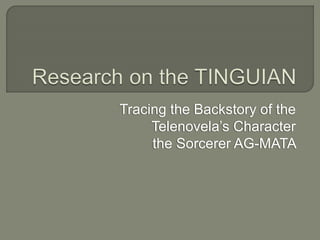
Research on the TINGUIAN
- 1. Tracing the Backstory of the Telenovela’s Character the Sorcerer AG-MATA
- 2. Texts and Illustrations are from The Tinguian Social, Religious, and Economic Life of a Philippine Tribe by Fay-Cooper Cole
- 3. In the book’s Introduction, Fay-Cooper Cole writes: This second and concluding section of Volume XIV gives the greater part of the results of an investigation carried out by me with the assistance of Mrs. Cole among the Tinguian, from January 1907 to June 1908: the funds for which were furnished Field Museum of Natural History by the late Robert F. Cummings.
- 4. The Tinguian and Ilocano…evidently left their ancient home as a unit, at a time prior to the Hindu domination of Java and Sumatra. Upon the arrival of Salcedo, the greater portion of the coast people accepted the rule of Spain and the Christian religion, while the more conservative element retired to the interior, and there became merged with the mountain people. To the Spaniards, the Christianized natives became known as Ilocano, while the people of the mountain valleys were called Tinguian, or mountain dwellers. The Tinguian are a pagan Philippine people who inhabit chiefly the mountain province of Abra in northwestern Luzon.
- 5. The Tinguian has been taught by his elders that he is surrounded by a great body of spirits, some good, some malevolent. The youth…attends the ceremonies, where he not only learns the details of…important events, but [also] the close relationship of the spirit world to his people. He has seen the bodies of the mediums possessed by the superior beings; he has communicated with them direct, has seen them cure the sick and predict coming events.
- 6. Ag-Mata’s ancestry may be based on two folk-tales. He could be either the son of a male spirit and his human wife or the placenta of a newborn baby. The first folk-tale recounts the story of BAYON, a male spirit who dwells in the sky and comes to earth as a breeze. He steals a girl called LOKADAYA and marries her. The second folk-tale reflects a firm conviction that a group of spirits, known as ALAN, sometimes take the placenta and transform it into a real child, who is then more powerful than ordinary mortals.
- 20. We are sharing some of our research to show our students that in the production of a period drama series and feature film such as VIGAN, infusing the backstory of fictional characters with some of the country’s cultural heritage can be quite a rewarding experience not only for the filmmaker but also for the viewer.
Editor's Notes
- Introduction and page 1.
- Pages 40 and 53.
- Pages 29 and 58.